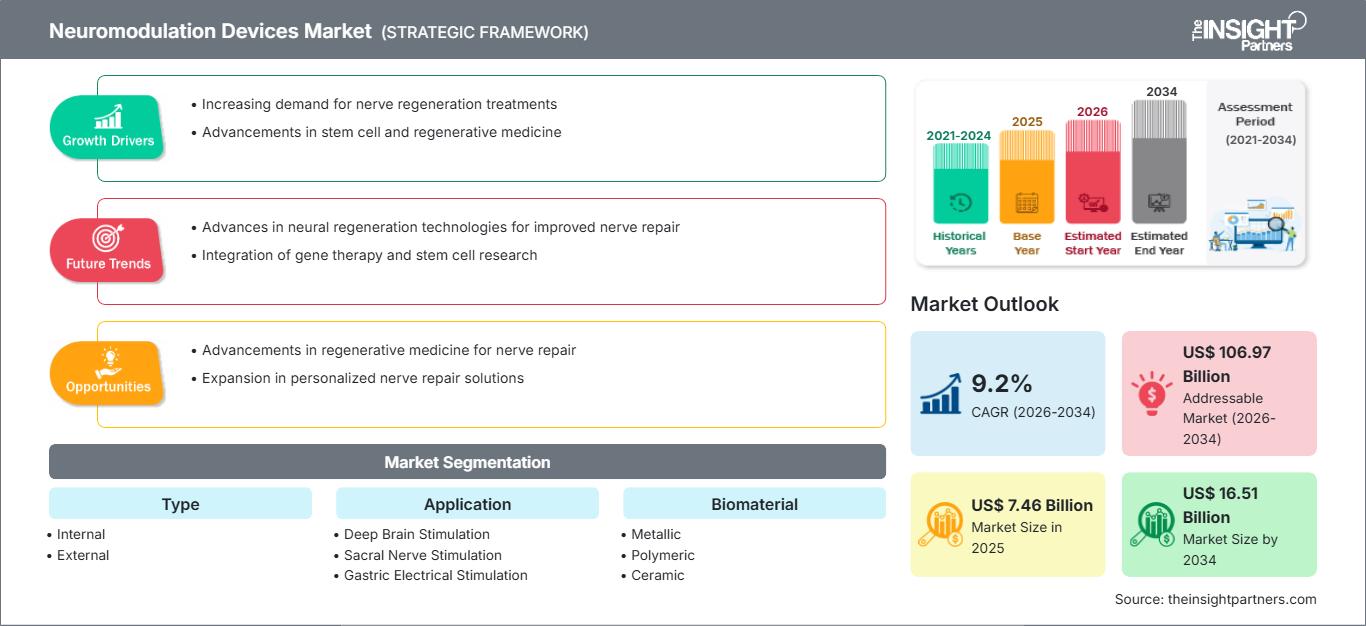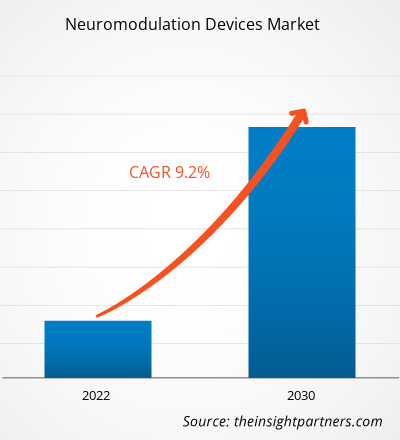Se proyecta que el mercado de dispositivos de neuromodulación, valorado en 7.460 millones de dólares estadounidenses en 2025, alcance los 16.510 millones de dólares estadounidenses en 2034, con una tasa de crecimiento anual compuesta (TCAC) del 9,2 % entre 2026 y 2034. Las condiciones del mercado siguen evolucionando, lo que genera nuevas oportunidades para las partes interesadas. El panorama general refleja un progreso estable y un potencial de crecimiento a largo plazo.
El uso de la neuromodulación está en rápido crecimiento, con una amplia gama de métodos tecnológicos implantables y no invasivos para el tratamiento de trastornos neuropsiquiátricos y neurológicos. Terapias como la estimulación cortical intracraneal (ICS), la estimulación magnética transcraneal (TMS), la estimulación cerebral profunda (ECP) y la estimulación transcraneal por corriente continua (tDCS) han mostrado resultados prometedores en diversos trastornos neuropsiquiátricos y neurológicos. Los dispositivos de neuromodulación son instrumentos médicos avanzados que pueden ajustar la actividad del sistema nervioso. Esta tecnología se utiliza para tratar trastornos del movimiento como la distonía, la enfermedad de Parkinson, temblores, tinnitus, trastorno obsesivo-compulsivo, discapacidades sensoriales, epilepsia, control de la vejiga, cefalea, dolor crónico, accidente cerebrovascular, estado de mínima consciencia, espasticidad y lesión medular. Factores como el aumento de casos de lesión medular y la creciente prevalencia de trastornos neurológicos contribuyen al creciente tamaño del mercado de dispositivos de neuromodulación.
Factores impulsores del mercado:
La población geriátrica es susceptible a las enfermedades neurológicas. Los trastornos neurológicos comunes que afectan a las personas mayores son la neuropatía, la enfermedad de Parkinson, la enfermedad de Alzheimer, la distonía y otros. Según el Departamento de Asuntos Económicos y Sociales de las Naciones Unidas, en 2022, había 771 millones de personas de 65 años o más a nivel mundial. Se prevé que la población de personas mayores alcance los 994 millones para 2034 y los 1600 millones para 2050. Países como Estados Unidos y Canadá presentan altas tasas de prevalencia de trastornos del movimiento y trastornos psiquiátricos asociados con el crecimiento de la población geriátrica. Según la Fundación Parkinson, los síntomas de Parkinson son comunes a una edad promedio de 60 años.
La Asociación Canadiense de Psicología afirma que el trastorno obsesivo-compulsivo (TOC) afecta a aproximadamente el 2% de la población canadiense. La Organización Mundial de la Salud (OMS) afirma que la epilepsia es un trastorno neurológico que causa convulsiones y que afecta a unos 50 millones de personas en todo el mundo. Según la Academia Estadounidense de Neurología, el accidente cerebrovascular es la tercera causa principal de muerte en Estados Unidos, seguida del Alzheimer como sexta. Las estadísticas de la misma fuente muestran que casi un millón de estadounidenses padecen párkinson y que se reportan al menos 60.000 nuevos casos al año. La creciente prevalencia de enfermedades neurológicas, sumada a trastornos relacionados con el estilo de vida, como la depresión y el dolor crónico, conduce a la creciente adopción de productos tecnológicamente avanzados.
Por lo tanto, la creciente población geriátrica propensa a enfermedades neurológicas, la creciente prevalencia de las enfermedades y la creciente conciencia sobre la enorme carga de los trastornos neurológicos impulsan el crecimiento del mercado de dispositivos de neuromodulación.
La neurociencia se centra en el tratamiento de trastornos como accidentes cerebrovasculares, cefaleas, esclerosis múltiple y otros casos graves. En los últimos años, se ha observado una escasez relativa de personal neurológico cualificado, incluso en países desarrollados. En Estados Unidos, existen más de 5700 hospitales; sin embargo, estos cuentan con menos de 3700 neurocirujanos. Un factor importante responsable de la insuficiencia del personal neuroquirúrgico es la incapacidad de formar neurocirujanos adecuadamente capacitados en un plazo adecuado. En las zonas urbanas existen centros de neurología con tecnología avanzada. Sin embargo, en las zonas rurales se ofrecen tratamientos limitados debido a la escasez de profesionales expertos. Por lo tanto, la escasez de neurocirujanos cualificados obstaculiza el crecimiento del mercado de dispositivos de neuromodulación.
Personalice este informe según sus necesidades
Obtendrá personalización en cualquier informe, sin cargo, incluidas partes de este informe o análisis a nivel de país, paquete de datos de Excel, así como también grandes ofertas y descuentos para empresas emergentes y universidades.
Mercado de dispositivos de neuromodulación: Perspectivas estratégicas

-
Obtenga las principales tendencias clave del mercado de este informe.Esta muestra GRATUITA incluirá análisis de datos, desde tendencias del mercado hasta estimaciones y pronósticos.
Segmentación y alcance del informe:
El “análisis del mercado de dispositivos de neuromodulación” se ha realizado considerando los segmentos: tipo, aplicación, biomaterial y usuario final.
Análisis segmentario:
El mercado de dispositivos de neuromodulación, por tipo, se divide en externo e interno. El segmento de neuromodulación interna tuvo la mayor cuota de mercado en 2022. Sin embargo, es probable que el segmento de neuromodulación externa registre una mayor tasa de crecimiento anual compuesta (TCAC) entre 2022 y 2030. El término "neuromodulación interna" describe el uso de dispositivos médicos que proporcionan estimulación eléctrica, química o de otro tipo para dianas neuronales específicas con el fin de modular o alterar la actividad del sistema nervioso. Esta técnica se utiliza para tratar enfermedades neurovasculares, anomalías del movimiento, epilepsia, dolor crónico e incontinencia fecal y urinaria.
Por usuario final, el mercado de dispositivos de neuromodulación se segmenta en hospitales, clínicas y atención médica domiciliaria. En 2022, el segmento hospitalario dominó la cuota de mercado de dispositivos de neuromodulación. Debido a la expansión de numerosos hospitales y clínicas y al aumento del gasto público en infraestructura sanitaria, este segmento domina actualmente el mercado. Además, se prevé que el envejecimiento de la población provoque una mayor prevalencia del dolor crónico, lo que impulsará la demanda de dispositivos de neuromodulación en los hospitales.
Análisis regional:
El alcance del informe de mercado de dispositivos de neuromodulación está segmentado principalmente en América del Norte (EE. UU., Canadá y México), Europa (España, Reino Unido, Alemania, Francia, Italia y el resto de Europa), Asia Pacífico (Corea del Sur, China, India, Japón, Australia y el resto de Asia Pacífico), Medio Oriente y África (Sudáfrica, Arabia Saudita, Emiratos Árabes Unidos y el resto de Medio Oriente y África) y América del Sur y Central (Brasil, Argentina y el resto de América del Sur y Central).
En términos de ingresos, América del Norte dominó la participación de mercado de dispositivos de neuromodulación en 2022. La creciente prevalencia de enfermedades neurológicas, el alto gasto en investigación y desarrollo, el creciente número de aprobaciones de productos por parte de la FDA y los avances tecnológicos impulsan la demanda de dispositivos de neuromodulación en la región.
Dispositivos de neuromodulación
Perspectivas regionales del mercado de dispositivos de neuromodulación
Los analistas de The Insight Partners han explicado detalladamente las tendencias regionales y los factores que influyen en el mercado de dispositivos de neuromodulación durante el período de pronóstico. Esta sección también analiza los segmentos y la geografía del mercado de dispositivos de neuromodulación en América del Norte, Europa, Asia Pacífico, Oriente Medio y África, y América del Sur y Central.
Alcance del informe de mercado de dispositivos de neuromodulación
| Atributo del informe | Detalles |
|---|---|
| Tamaño del mercado en 2025 | US$ 7.46 mil millones |
| Tamaño del mercado en 2034 | US$ 16.51 mil millones |
| CAGR global (2026-2034) | 9,2% |
| Datos históricos | 2021-2024 |
| Período de pronóstico | 2026-2034 |
| Segmentos cubiertos |
Por tipo
|
| Regiones y países cubiertos |
América del norte
|
| Líderes del mercado y perfiles de empresas clave |
|
Densidad de actores del mercado de dispositivos de neuromodulación: comprensión de su impacto en la dinámica empresarial
El mercado de dispositivos de neuromodulación está creciendo rápidamente, impulsado por la creciente demanda del usuario final debido a factores como la evolución de las preferencias de los consumidores, los avances tecnológicos y un mayor conocimiento de los beneficios del producto. A medida que aumenta la demanda, las empresas amplían su oferta, innovan para satisfacer las necesidades de los consumidores y aprovechan las tendencias emergentes, lo que impulsa aún más el crecimiento del mercado.

- Obtenga una descripción general de los principales actores clave del mercado de dispositivos de neuromodulación
Panorama competitivo y empresas clave:
El informe del mercado de dispositivos de neuromodulación se centra en actores destacados del mercado como Abbott (St. Jude Medical, Inc.), LivaNova PLC, Boston Scientific Corporation, Aleva Neurotherapeutics SA, Bioventus, EnteroMedics Inc., Nevro Corporation, NeuroPace Inc., Synapse Biomedical Inc. y Neurosigma Inc. El pronóstico del mercado de dispositivos de neuromodulación puede ayudar a las partes interesadas a planificar sus estrategias de crecimiento. Estas empresas se centran en nuevas tecnologías, la modernización de productos existentes y la expansión del mercado para satisfacer la creciente demanda de los consumidores en todo el mundo. Según comunicados de prensa de las empresas, a continuación se presentan algunos desarrollos clave recientes:
- En agosto de 2023, Medtronic plc recibió la aprobación del Marcado CE para su estimulador de médula espinal (EME) recargable de circuito cerrado Inceptiv. Es el primer dispositivo EME de Medtronic que ofrece una función de circuito cerrado que detecta las señales biológicas únicas de cada persona y ajusta la estimulación en cada momento, según sea necesario, para que la terapia se adapte a las actividades de la vida diaria.
- En agosto de 2023, Abbott recibió la aprobación de la Administración de Alimentos y Medicamentos de los Estados Unidos (FDA) para su nuevo sistema de estimulación de la médula espinal (EME) Proclaim Plus, con la terapia FlexBurst360. La terapia FlexBurst360, la nueva generación de la estimulación BurstDR patentada por Abbott, ofrece cobertura del dolor en seis zonas del tronco y/o extremidades. Facilita una programación que se puede ajustar según las necesidades terapéuticas de cada persona.
- Análisis histórico (2 años), año base, pronóstico (7 años) con CAGR
- Análisis PEST y FODA
- Tamaño del mercado, valor/volumen: global, regional y nacional
- Industria y panorama competitivo
- Conjunto de datos de Excel
Informes recientes
Testimonios
Razón para comprar
- Toma de decisiones informada
- Comprensión de la dinámica del mercado
- Análisis competitivo
- Información sobre clientes
- Pronósticos del mercado
- Mitigación de riesgos
- Planificación estratégica
- Justificación de la inversión
- Identificación de mercados emergentes
- Mejora de las estrategias de marketing
- Impulso de la eficiencia operativa
- Alineación con las tendencias regulatorias






















 Obtenga una muestra gratuita para - Mercado de dispositivos de neuromodulación
Obtenga una muestra gratuita para - Mercado de dispositivos de neuromodulación